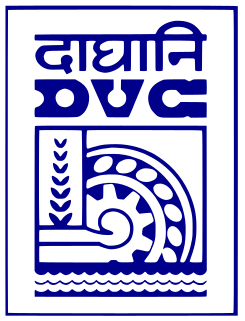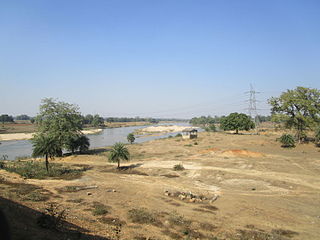Sunder Das Khungar | |
|---|---|
| Born | India |
| Occupation | Civil engineer Civil servant |
| Known for | Bhakra Dam Khungar Commission |
| Awards | Padma Bhushan |
Sunder Das Khungar was an Indian civil servant, civil engineer and the general manager of the Bhakra Dam project. [1] It was his proposal that the dam, originally built for irrigation, to be utilized for power generation by incorporating five hydro electric generation units. [2] He headed the commission set up by the Ministry of Irrigation and Power in 1960 to look into the water management operations of the Damodar Valley Corporation. [3] The Government of India awarded him the third highest civilian honour of the Padma Bhushan, in 1955, for his contributions to civil service. [4]

Damodar River is a river flowing across the Indian states of Jharkhand and West Bengal. Rich in mineral resources, the valley is home to large-scale mining and industrial activity. Earlier known as the Sorrow of Bengal because of its ravaging floods in the plains of West Bengal, the Damodar and its tributaries have been somewhat tamed with the construction of several dams. It is the most polluted river of India.

Bhakra Dam is a concrete gravity dam on the Sutlej River in Bilaspur, Himachal Pradesh in northern India. The dam forms the Gobind Sagar reservoir.

Damodar Valley Corporation (DVC) is an Indian governmental organization which operates in the Damodar River area of West Bengal and Jharkhand states of India. The corporation operates both thermal power stations and hydel power stations under the Ministry of Power, Govt of India. DVC is headquartered in the city of Kolkata, West Bengal, India.

The Barakar River is the main tributary of the Damodar River in eastern India. Originating near Padma in Hazaribagh district of Jharkhand it flows for 225 kilometres (140 mi) across the northern part of the Chota Nagpur Plateau, mostly in a west to east direction, before joining the Damodar near Dishergarh in Asansol, Bardhaman district of West Bengal. It has a catchment area of 6,159 square kilometres (2,378 sq mi). The main tributaries, Barsoti and Usri, flow in from the south and north respectively. Apart from the two main tributaries some fifteen medium or small streams join it.

The Maithon Dam is located at Maithon, 48 km from Dhanbad, in the state of Jharkhand. It is 15,712 ft (4,789 m) long and 165 ft (50 m). high.

Panchet Dam was the last of the four multi-purpose dams included in the first phase of the Damodar Valley Corporation. It was constructed across the Damodar River at Panchet in Dhanbad district in the Indian state of Jharkhand, and opened in 1959.
Kanuru Lakshmana Rao was an Indian engineer and a Padma Bhushan awardee who served as the Union Minister of Irrigation & Power and Member of Parliament for Vijayawada from 1962 to 1977.

Konar dam is the second of the four multi-purpose dams included in the first phase of the Damodar Valley Corporation. It was constructed across the Konar River, a tributary of the Damodar River in Hazaribagh district in the Indian state of Jharkhand and opened in 1955. The place has scenic beauty and has been developed as a recreational spot.
Kanwar Sen, also spelt as Rai Bahadur Kanwar Sain OBE (1899–1979) was a civil engineer from Haryana state in India. He was the chief engineer in the Bikaner state who came up with idea of Rajasthan Canal. He also successfully implemented Ganga canal project. He was considered a doyen of irrigation engineering of his time. He was born in 1899 in Tohana in Hisar district (Haryana). He was educated at D.A.V. College, Lahore. He graduated as a civil engineer from Thomason College of Civil Engineering, Roorkee in the year 1927 with hons. He was awarded Padma Bhushan in 1956. He has written a book called -Reminiscences of an engineer. He was chairman of Central Water and Power Commission, Ministry of Irrigation and Power, Government of India. Kanwar sain and Karpov (1967) presented enveloping curves for Indian rivers.

Durgapur Barrage is built across the Damodar River at Durgapur in Bankura district and partly in Paschim Bardhaman district in the Indian state of West Bengal. It was constructed by Damodar Valley Corporation mainly for the purpose of irrigation and also to supply water to Industrial township of Durgapur. The irrigation and canal system was transferred to the Government of West Bengal in 1964.

Tilaiya Dam was the first of the four multi-purpose dams included in the first phase of the Damodar Valley Corporation. It was constructed across the Barakar River, at Tilaiya in Koderma district in the Indian state of Jharkhand and opened in 1953.

The Ukai Dam, constructed across the Tapi River, is the second largest reservoir in Gujarat after the Sardar Sarovar. It is also known as Vallabh Sagar. Constructed in 1972, the dam is meant for irrigation, power generation and flood control. Having a catchment area of about 62,255 km2 and a water spread of about 52,000 hectares, its capacity is almost same as that of the Bhakra Nangal Dam. The site is located 94 km from Surat.
Jaiprakash Gaur is an Indian entrepreneur. He founded and, until his retirement in 2010, was the chairman of Jaypee Group, a conglomerate with a heavy emphasis on engineering and construction, cement, and hydropower production. In 2012 he was ranked by Forbes magazine as the 70th-richest person in India, with an estimated net worth of US$855 million. Gaur has been associated with the construction industry for more than five decades.

The Pandoh Dam is an embankment dam on the Beas River in Mandi district of Himachal Pradesh, India. Under the Beas Project, the dam was completed in 1977 and its primary purpose is hydroelectric power generation. Part of a run-of-the-river power scheme, it diverts the waters of the Beas to the southwest through a 38 km (24 mi) long system of tunnels and channels. The water is used for power generation at the Dehar Power House before being discharged into the Sutlej River, connecting both rivers. The power house has an installed capacity of 990 MW. The system diverts 256 cumecs of Beas waters to the Satluj River. The project was completed in 1977.
Ajudhia Nath Khosla was an Indian engineer and politician. He was the Chairman of the Central Waterways Irrigation and Navigation Commission of India.

Lakhwar-Vyasi Dam project on Yamuna River, includes under-construction Lakhwar Dam and Power Station, Vyasi Dam, Hathiari Power Station and Katapathar Barrage, near the Lakhwar town in Kalsi block of Dehradun district of Uttarakhand in India, for the purpose of irrigation of 40,000 hectare land and total 927 MW hydroelectric power generation. "Lakhwar Dam" is a gravity dam near the Lohari village with 300MW power generation capacity. "Vyasi Dam" will be built 5 km downstream along with 120 MW "Hathiari Power Station" further 0.5 km downstream. "Katapathar Barrage", with the maximum ponding water level at 514.5m elevation, will be built further 2.75 km downstream of the Hathiari Power Station to supply the water to stakeholder states. Project will hold 580 million cubic metres water during monsoon and release into Yamuna during dry months.

The Kishau Dam is a proposed gravity dam on the Tons River which will straddle the border between the Indian states of Himachal Pradesh and Uttarakhand. The project site is located about 39 km (24 mi) north of Dakpathar and upstream of the Ichari Dam. The primary purpose of the dam is power generation and downstream water supply. It will support a 660 MW power station and provide water for the irrigation of 97,076 ha of crops.
Niranjan Das Gulhati was an Indian civil engineer, water resources consultant and writer, known for his mediation in the Indus Waters Treaty of 1960 between India and Pakistan. His contributions were reported in the formation of the International Commission on Irrigation and Drainage (ICID), a non governmental organization which promotes transfer of water sharing technologies between countries. An Alumnus of the Thomason College of Engineering, he was associated with the World Bank, International Development Association and United Nations Economic and Social Commission for Asia and the Pacific. He was the author of two books, Indus Waters Treaty: An Exercise in International Mediation and Data Of High Dams In India. The Government of India awarded him the third highest civilian honour of the Padma Bhushan, in 1961, for his contributions to society. His life story has been documented in a book, The Untiring Indian - Lifestory of Mr. N. D. Gulhati - A Visionary Water Resources Engineer, published in 2011. The International Commission on Irrigation and Drainage has instituted an annual oration, N.D. Gulhati Memorial Lecture for International Cooperation in Irrigation and Drainage in his honor.
Nori Gopala Krishna Murti was an Indian civil engineer, known for his contributions for the implementation of Koyna Hydroelectric Project. He was the chairman of Bhakra Dam Management Board and the vice-chairman of the International Congress on Large Dams. The Government of India awarded him the Padma Shri, the fourth highest civilian award, in 1963. He received the Padma Bhushan, the third highest civilian award, in 1972.
| This article about an Indian engineer, inventor or industrial designer is a stub. You can help Wikipedia by expanding it. |